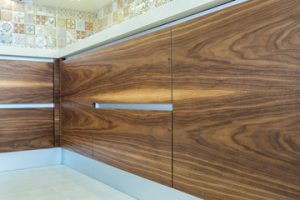Cabinet Refinishing Sacramento is a great choice for homeowners that like the aesthetic of their cabinets but want to refresh their look. This process involves sanding down the existing wooden surfaces of your cabinetry and adding new coats of paint or stain.

Refinishing is limited to the existing cabinet structure. If you want to change the door style or wood species, you would need to choose refacing instead.
Cabinet refinishing is an excellent way to give your kitchen a fresh new look without breaking the bank. It also doesn’t require any structural changes, which can be costly and time-consuming. However, there are some important things to consider before deciding whether or not to refinish your cabinets.
While it may seem like a less expensive option than replacing your cabinets, refinishing can actually cost more in the long run. The reason for this is that paint jobs don’t last very long in a kitchen environment. The constant opening and closing of doors, along with the contact with grease and moisture on a regular basis, are extremely harmful to most paint products. This is why NHance only uses high-quality, durable finishes for its cabinet refinishing projects.
Unlike painting, cabinet refinishing involves a thorough cleaning and degreasing of your cabinet surfaces followed by the application of several coats of stain to your cabinets’ wooden surface. It can focus solely on your cabinet doors or include the entire cabinet box. It is a less invasive process than replacing your cabinets, which can leave your kitchen unusable for days or weeks at a time, depending on the scope of the project.
Another consideration when deciding between refinishing and replacing your cabinets is the cost of hardware. If you decide to refinish your cabinets, you’ll need to purchase new knobs and pulls for your drawers and cupboards. This can be an additional expense, especially if you choose to install an oil-rubbed bronze, polished nickel or pewter finish.
Before you refinish your cabinets, be sure to protect your countertops, appliances and floors with drop cloths and tape to avoid stains. It is also a good idea to label your cabinet doors or number them so you can put them back in the right place after the refinishing process is complete. It is also a good idea to use a chemical stripper in a well-ventilated area and to wear eye protection and gloves when using these chemicals. If you’re not comfortable using chemical products, it may be a better idea to hire a professional refinisher.
Benefits
Cabinet refinishing is an ideal solution for homeowners who want to breathe new life into their kitchens without the expensive, time-consuming commitment of a complete renovation. The process involves sanding down and repainting cabinets to restore their surface beauty and durability. It can be done in just a few days, providing significant time savings over a complete remodel.
A major benefit of refinishing your cabinets is that it preserves the quality craftsmanship and design of your current cabinets. It also opens up a variety of customization options, so you can achieve the updated look you desire without having to completely replace your cabinets. This can be a cost-effective solution for older homes that have high-quality cabinets that would be a shame to waste.
In contrast, a full replacement requires removing and installing new cabinets, which can take weeks to complete. Additionally, the demolition and construction processes generate a lot of dust and mess, which can disrupt your home’s comfort and cause health hazards. On the other hand, refinishing your cabinets can be completed in just a few days, leaving you with a fresh, modern kitchen.
Refinishing is a greener option than replacing your cabinets, as it recycles the majority of existing materials. The cabinet replacement process involves tearing out perfectly functional cabinets and contributing to landfill waste. Cabinet refinishing, on the other hand, minimizes waste by using the existing frame and only replacing the cabinet doors. It’s an eco-friendly alternative that can be complemented with other environmentally conscious improvements, including energy-efficient appliances and lighting.
Investing in a refinished kitchen can significantly increase your home’s value and appeal to potential buyers. It can boost your home’s marketability and resale value, giving you the funds to invest in other value-boosting projects like new flooring and kitchen appliances.
Adding value to your home is one of the best ways to get a return on your investment. A clean, attractive kitchen can be a big selling point for buyers, and investing in cabinet refinishing is a great way to improve your kitchen’s aesthetic and functionality without breaking the bank on a major renovation.
Time
The length of time it takes to complete a Cabinet Refinishing project will depend on a variety of factors, such as your personal schedule, the size of your kitchen, and the amount of work involved. It’s best to plan ahead and choose a project timeline that works well with your family, work, and social life. You can also reduce the overall time by choosing a paint that dries quickly and requires less touch-ups.
Before you start painting, it’s important to prepare the cabinets by thoroughly cleaning and sanding them. This step can take 2-4 hours, and it’s essential for ensuring a smooth surface that will hold up to the new paint. You can use a power sander for flat areas, but hand-sanding is often needed for more detailed surfaces. Be sure to clean up any dust or debris between sanding sessions, as this will prevent the new paint from sticking.
Primer is another critical part of the process and can take 2-4 hours to apply. It will help the new coat of paint adhere to the cabinets and will block any stains or wood grain from showing through. Be sure to use a primer that is specifically made for cabinets, as this will ensure a long-lasting finish.
Once the primer is dry, you can begin applying the first coat of paint. This can take 2-4 hours to apply, and it’s important to allow the paint to dry for at least 24 hours before applying additional coats. Once the final coat of paint is applied, it’s important to let the cabinets rest and cure for at least a week before reattaching doors and hardware.
Cabinet refacing is an excellent option for homeowners who want to update their kitchens without the expense and hassle of replacing all the cabinets. Refacing is much faster than replacing your cabinets and can save you up to 80% of the cost.
Safety
Cabinet refinishing is an excellent option for homeowners who are looking to update their home without spending a fortune on new cabinets. Refinishing is a process that involves changing the look of existing cabinetry by sanding and chemically stripping the old finish, and then applying a new stain or paint. However, this process can be dangerous if it is not done properly.
It is essential to take safety measures when refinishing your kitchen cabinets. This includes wearing protective clothing, using a respirator and opening windows in the room to ventilate. It is also important to keep children, pets and elderly family members out of the room while refinishing. This will help to minimize their exposure to harmful chemicals.
Before painting, it is necessary to prepare the surface for painting by sanding and priming. It is recommended to use a water-based primer. These products contain less volatile organic compounds (VOCs) and are safer for the environment. Moreover, they dry quickly and do not produce as many fumes as oil-based primers.
Once the cabinet is prepped, it can be painted with a latex or oil-based paint. It is important to use a high-quality brush or roller and apply multiple coats to achieve an even appearance. After completing the painting, it is important to let the cabinets dry completely before moving them. It is also important to label or number the doors if they are removed before refacing so that you can easily put them back in place after refacing them.
It is also a good idea to use a clean drop cloth to protect countertops, appliances and floors from spills or splatters. Lastly, it is crucial to make sure that the work area is well-ventilated when working with any chemicals such as strippers and paints. It is best to do this outside if possible, and to always wear dust masks and goggles. You can also test the old paint to see if it is oil-based or latex by rubbing a cotton ball with denatured alcohol.
